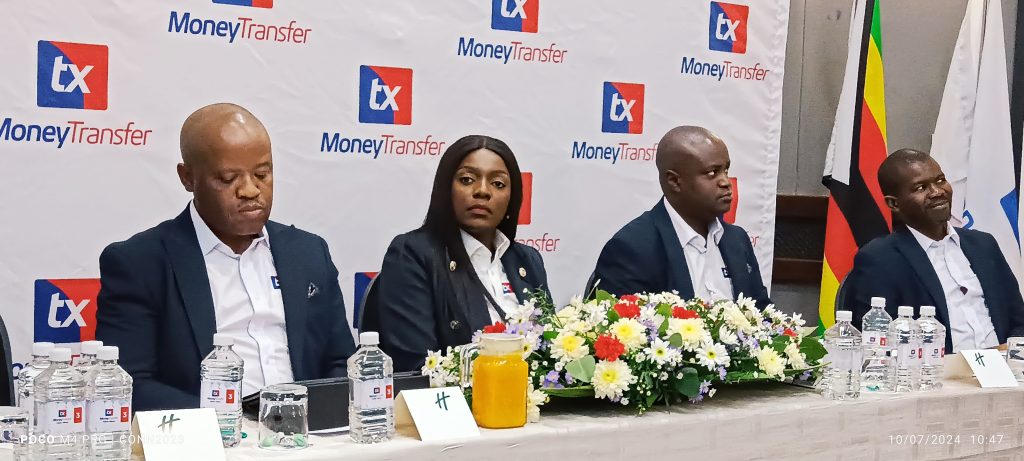- TX Money Transfer launched
- Product aggregates remittances services
- TX courting international players
TX MONEY Transfer, which has adopted a marketplace approach for remittances, mirroring shared infrastructure in telecommunications and toll manufacturing and seeks to address inefficiencies at collection points, has been launched.
The new product, which works in partnerships with other remittance providers, targets “far-flung areas” through small supermarkets in rural areas.
TX Money Transfer is a subsidiary of Bard Santner Incorporated, established in Zimbabwe in 2022 with a reach extending to neighboring countries such as Botswana, South Africa, Zambia, Mauritius, the United Kingdom, and the United States of America.
 “We are growing that network; we want to reach far-flung areas. If you look at most of the partners that we will be signing on, small supermarkets, definitely there is a trust to get to the rural areas,” said Bard Santner Incorporated CEO Senzwani Sikhosana.
“We are growing that network; we want to reach far-flung areas. If you look at most of the partners that we will be signing on, small supermarkets, definitely there is a trust to get to the rural areas,” said Bard Santner Incorporated CEO Senzwani Sikhosana.
“We can’t talk about financial inclusion when we are not talking about actually reaching those far-flung areas. So definitely there is a trust to actually make sure we cover the whole country,” said Sikhosana.
So, how does TX Money Transfer work?
Imagine a bustling marketplace where multiple vendors sell similar products, such as fruits and vegetables.
Traditionally, each vendor would operate independently, resulting in duplicated efforts in sourcing products, logistics, and customer attraction. This leads to a crowded market with redundant services, where vendors invest resources in similar activities.
Now, envision a central marketplace offering shared infrastructure for all vendors. This marketplace provides common facilities like transportation and storage.
Vendors no longer need to manage logistics as the central marketplace streamlines operations, reduces costs, and offers shared resources. They can focus on attracting customers, enhancing their offerings, and providing superior customer service. Rather than thinking as individual vendors, TX Money Transfer adopt a marketplace approach as a hub. The outcome benefits end-users through cost savings and reliable service. This concept mirrors shared infrastructure in telecommunications and toll manufacturing.
Why not apply this to remittances?
“Our model is built on partnerships. Through strategic collaborations, we provide a platform for other remittance providers to deliver reliable services to their clients. No individual should be left behind, and neither should any remittance player. We therefore extend our hand to local and international remittance players to be your last-mile partner,” according to another Executive Director, Lucia Chingwaru.
Sikhosana chipped in saying TX focuses on the last mile of the value chain in terms of transactions.
“So, what we say to other remittance players is that you are running the first mile and we’re running the last mile. TX is not a duplicate. Eventually, we can have a hub of other remittance players who don’t want to do the last mile.
“Why don’t we all aggregate that last mile, which is most problematic?
That way we are streamlining the issue of cost. That’s what makes us different from everyone else.
We are not coming to compete; we are coming to complement,” said Sikhosana.
The remittance industry in Zimbabwe is currently characterized by the physical cash outflow of sent funds. The necessity of cash transactions poses several challenges at the point of collection. Receivers often encounter obstacles such as system failures, insufficient funds at collection points, long waiting times, and undisclosed charges that become apparent only upon collection. When analyzing the entire value chain, it becomes evident that sending money is efficient, but the collection process is inefficient.
TX Money Transfer seeks to address these concerns by focusing on the final stage of the value chain – the collection points.
Moreover, the remittance market is fragmented, resulting in redundant efforts. For instance, multiple remittance services often deliver funds to the same destination, leading to Inefficiencies and increased transaction costs. These challenges will be mitigated through partnerships with other remittance providers, assisting in their disbursements as part of the value chain.
“We are currently offering this service to InnBucks and finalizing similar agreements with other key players in the market,” said Chingwaru.
“At TX Money Transfer, we are establishing a robust and dependable hub that other remittance providers can count on,” said Tatenda Hungwe another Executive Director with TX Money Transfer.
Feedback: [email protected]










